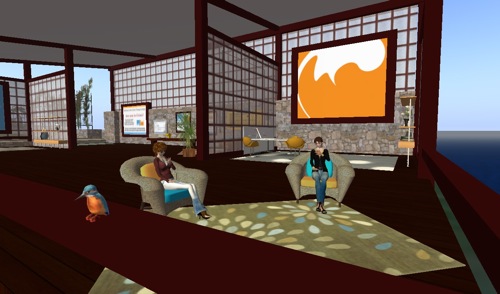1. The Economist (UK) – Intangible value. “Perhaps it should not be a surprise. In the midst of a global capital shortage, the first company to list this year on New York’s NASDAQ exchange not only needs no money; its source of profit is receiving cash for items that do not exist. Changyou is a three-year-old online-gaming business being spun out of Sohu, China’s second-largest internet portal. The deal was due to be priced on April 2nd, as The Economist went to press, in a nostalgic reminder of what the stockmarket used to look like. At the top of the expected price range Changyou will be valued at about $820m, after a special distribution of $100m to its parent. The opening price may be higher still, given strong demand.”
2. Virtual Edge (USA) – Virtual World Evangelist at IBM Produces Virtual Meetings in 3D. “Big Blue has a lot of irons in the fire these days. As a virtual event platform agnostic company, IBM has worked with Second Life, Open Sim, Torque, Active Worlds, Unity 3D and Olive. Karen Keeter, a marketing executive with IBM research, believes that, at this point, no single platform is the magic bullet for all 3D virtual business demands. IBM virtual event clients (internal and external) demonstrate needs across a wide spectrum, from strategy workshops to marketing and sales to collaboration among a global workforce, and the company utilizes a variety of platforms, in some cases integrated with IBM tools and applications, to meet these new demands. IBM has a strong presence on Second Life, growing from approximately 12 virtual islands to somewhere between 45 and 50 which are managed independently of IBM’s corporate home base.”
3. Washington Post (USA) – Virtual World Habbo Sold $60 Million In Virtual Goods In 2008. “Sulake Corp., parent company of Habbo, one of the most heavily-trafficked, advertiser-friendly virtual worlds for teens, is privately held, so financial details about Habbo have been a bit of a black box. But the company recently served up some details: It says it brought in roughly $74 million (50 million euros) in revenue last year. And just about $60 million of it, or 80-85 percent, came from users who bought virtual goods like furniture, clothing or paid for access to the Habbo Club.”
4. Idaho Business Review (USA) – U of I virtual technology program aids microbiology research. “What if doctors could perform surgery from thousands of miles away? Or an architect could walk into a virtual building plan and move beams and joists to test for structural integrity? What if you could meet with potential business partners online, shake hands and physically feel it? Those are just a few of the long-term implications of the work being done by the University of Idaho’s Virtual Technology and Design department – a program in the College of Art and Architecture on the bleeding edge of virtual reality, where complex sets of data like building specs or disease pathology are transformed into interactive 3-D models that allow students, businesses and researchers to gain new insights into the information they work with.”
5. The Times of India (India) – For training, medicos turn to Second Life. “A British medical institute has given e-learning a whole new dimension. Med students at Imperial College London navigate a full-service hospital where they see patients, order X-rays, consult with colleagues and make diagnoses. But none of it is real. These prospective doctors are treating virtual patients in Second Life, the internet world where users interact through online alter egos called avatars. The third-year med students are taking part in a pilot program for game-based learning, which educators believe can be a stimulating change from lectures and textbooks, reports CNN.”
6. The Telegraph (UK) – Second Life’s span is virtually over as firms decide to get real. “While the site is still beloved by geeks and the socially awkward, Deloitte’s director of technology research, Paul Lee, says it has been “virtually abandoned†by “normal†people and businesses. In 2006 multinational companies, including BT, Coca-Cola, Adidas and Toyota, were scrabbling to create “in world†presences to profit from what was expected to be the next great internet cash cow. But today the Second Life high street is mostly deserted, as businesses have realised that despite management claims that the site has 15m members, far fewer people actually play the game. Research for The Daily Telegraph shows just 580,000 people logged on to the game last week.”
7. InternetNews.com (USA) – SimCity’s Will Wright: ‘Web Colliding With Reality’. “The richness of Web-based environments is starting to blur the distinction between games and reality, according to Will Wright, the gaming industry legend perhaps best known as the creator of SimCity and Spore.
“I think the Web is letting people think more about their identities and we’re starting to see overlap of [the real] and virtual environments,” Wright said during an onstage keynote interview here at the Web 2.0 Expo Thursday. “We’re at the point where we can pretty much hold up a cell phone to get someone’s profile. I think the Web is starting to intersect and collide with reality in interesting ways.”
8. The National (UAE) – The net effect of digital Islam. “I am writing in the shadow of a small mosque. This morning I visited several other mosques, admiring their architecture, and then listened to some sermons and recitations from the Quran. While having my coffee I talked to acquaintances on Islamic issues and went to other sources for information on Islamic medicine, fatwas and jihad in Somalia.
The fact that I happen to be in the heart of Wales and stuck in my university office has not prevented me from making these visits and engaging in these discussions.”
9. Scientific American (USA) – Therapists Use Virtual Worlds to Address Real Problems. “When a troubled 13-year-old named Joe first entered the Kids in Transition program in 2007 in Camden, N.J., he hardly spoke to his therapist. Like many teens at this residential mental health treatment facility, he was admitted because he had trouble controlling his anger, had run away from home several times, and had a history of run-ins with the law, according to Heather Foley, a social worker with the program. Therapists typically encourage patients like Joe to get at the core of their problems via face-to-face role-playing—pretending to be in a situation and having the patient practice how to handle it. But Foley says this approach was a nonstarter for Joe, whose confrontational behavior and attention deficit hyperactivity disorder (ADHD) impair his ability to engage and focus in this way.”
10. Vineyard Gazette Online (USA) – Islanders Create Online Community Devoted to Wildlife Conservation. “The internet may have been designed for scientists to collaborate across vast distances, but it has since become all things to all people. Accessing seemingly infinite information and instant communication across the globe are still the main uses of the Web, but there’s a new trend swiftly becoming standard online practice: social networking. This is about creating a personal presence in cyberspace. Facebook and MySpace were some of the first major social networking sites, but another fast-growing sector of the social web, called Massively Multiplayer Online Role-Playing Games, or MMORPGs, represents a different kind of online community. Rather than creating a personal page that shares your thoughts, contact information and photographs as on Facebook, these MMORPGs ask the user to invent an avatar, a character that represents less of who you are and more of who you’d like to be. Players then move their avatars throughout vast virtual worlds, doing battle, completing quests, buying virtual goods and real estate, or just chatting with other players. Second Life, World of Warcraft and Everquest are among the more popular, with World of Warcraft now boasting over 10 million subscribers worldwide.”

 DeeAnna: I have a Master of Education in Rehabilitation Counseling and a Bachelor of Science in Mental Health and Human Services. I have worked in the mental health field for nearly 20 years. About 10 years ago I discovered the power of the Internet and began providing online chat and email through a couple of e-clinics. Over the years I have always maintained a part-time practice online and have integrated technology in work settings working with interns, employees and clinical supervisees. I have been training therapists since 2001 about the ethical issues pertaining to technology and mental health. Now 100% of my work life is devoted to either providing online therapy or teaching others about online therapy.
DeeAnna: I have a Master of Education in Rehabilitation Counseling and a Bachelor of Science in Mental Health and Human Services. I have worked in the mental health field for nearly 20 years. About 10 years ago I discovered the power of the Internet and began providing online chat and email through a couple of e-clinics. Over the years I have always maintained a part-time practice online and have integrated technology in work settings working with interns, employees and clinical supervisees. I have been training therapists since 2001 about the ethical issues pertaining to technology and mental health. Now 100% of my work life is devoted to either providing online therapy or teaching others about online therapy. Kate Anthony: I realised this in 2001 after speaking at a conference about Telephone Helplines. The Keynote speaker was head of BTExact Technologies, and he referred to the future of virtual worlds, and avatars specifically, being part of the future of health care. Most of the audience was laughing at the concept -– I wasn’t. I went on to work with him and his team to explore the concept and write a white paper on the topic (Anthony, K. and Lawson, M (2002). The Use of Innovative Avatar and Virtual Environment Technology for Counselling and Psychotherapy. Available online at www.kateanthony.co.uk/research).
Kate Anthony: I realised this in 2001 after speaking at a conference about Telephone Helplines. The Keynote speaker was head of BTExact Technologies, and he referred to the future of virtual worlds, and avatars specifically, being part of the future of health care. Most of the audience was laughing at the concept -– I wasn’t. I went on to work with him and his team to explore the concept and write a white paper on the topic (Anthony, K. and Lawson, M (2002). The Use of Innovative Avatar and Virtual Environment Technology for Counselling and Psychotherapy. Available online at www.kateanthony.co.uk/research).

Recent Comments